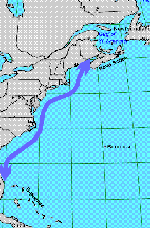 |
 |
 |
 |
 |
 |
 |
Right Whale Migration Update: March 29, 2000
Today's Report Includes:
- Greetings from the Stellwagen Bank
- Radio-Tagged Whales -Tracking Right Whales From Shore:Challenge Question #10
- There is Nothing Simple in Animal Behavioral Studies
- How to Solve the Puzzle
- Try This!
- Time to Focus on Cape Cod Bay
- How to Respond to Today's Challenge Questions
Greetings from the Stellwagen Bank National Marine Sanctuary.
I'm Anne Smrcina, the education coordinator of the sanctuary and your humpback whale correspondent. Not much has changed on the status of right whales up in the northern feeding ground of Cape Cod Bay. According to the National Marine Fisheries Service, from one to a dozen or more whales are being sighted on aerial and/or boat survey cruises. Aerial over-flights of the southern calving grounds have recorded few sightings this year. The word is still only one confirmed sighting of a mother-calf pair (much earlier in the season). It may be that other calves were born in other, non-patrolled areas, but researchers do not hold out much hope for any major changes in the numbers.
Radio-Tagged Whales -Tracking Right Whales From Shore
 |
Challenge Question #10
"Why would scientists be interested in studying the potential use of shore-based tracking methods and what do you think are some of the limitations of this type of tracking system?"
(To respond to this question, please follow the instructions below.)
Unfortunately for Dr. Hain, so few whales were seen in the waters off Florida this year where they set up operations
(and where in the past right whales have been regular visitors), that he and his fellow researchers were unable
to tag any of the whales for this study. (In past years the whales were seen in the Daytona Beach, New Smyrna and
Melbourne areas).
There is Nothing Simple in Animal Behavioral Studies
When scientists study animals they constantly ask questions and look for patterns in the animals' behavior. When patterns change, they study all the factors they can think of that might effect the changes. This year there seemed to be a tendency for the whales to show up in more northerly waters off the coasts of Georgia and South Carolina. They are also found to be somewhat further offshore. Scientists are not sure if these changes in habitat and the changes in the calving rate this season are just the sign of a single unusual year, or if they indicate a trend (there were only 4 calves last year).
How to Solve the Puzzle
One line of research is to look at whale positions and correlate this with sea surface temperatures using satellite images. Could it be that the surface waters are warming, leading to a shift in whale populations? Another way to look at this phenomenon is to ask whether the whales have used these more northern areas in the past, before there were scientific records. Could there have been unknown factors that caused the whales to move to the more southerly waters over the past few years?
Try This!
- Find the part of the world where Right Whales live, along the Atlantic Coast off the U.S. and Canada.
- Each time the month changes, tally whether the coastal waters were: Colder, Warmer or Normal
- Do you see any trends in northern waters that might have caused the whales to move south?
- Can you see how difficult it is for scientists to draw conclusions!?
Time to Focus on Cape Cod Bay
Now that the few whales in the southern grounds have departed, researchers will focus their attention on the group in Cape Cod Bay. They will take particular interest in making sure that boats are aware of their presence and that precautions are taken to avoid hitting them. Usually during the next couple of months the feeding forays range into the Great South Channel, a productive area of water between Cape Cod and Georges Bank (and also part of the major shipping channel from New York to Boston). Later in the summer the whales move on up to the Bay of Fundy and other areas off Nova Scotia.
This is Anne Smrcina, education coordinator of the Stellwagen Bank National Marine Sanctuary, signing off.
How to Respond to Today's Right Whale Challenge Question:
1. Address an E-mail message to: jn-challenge-rwhale@learner.org
2. In the Subject Line of your message write: Challenge Question #10.
3. In the body of the EACH message, give your answer to ONE question above.
The Next Right Whale Migration Update will Be Posted on April 12, 2000
Copyright 2000 Journey North. All Rights Reserved. Please send all questions, comments, and suggestions to our feedback form
 |
 |
 |
 |
 |
 |

